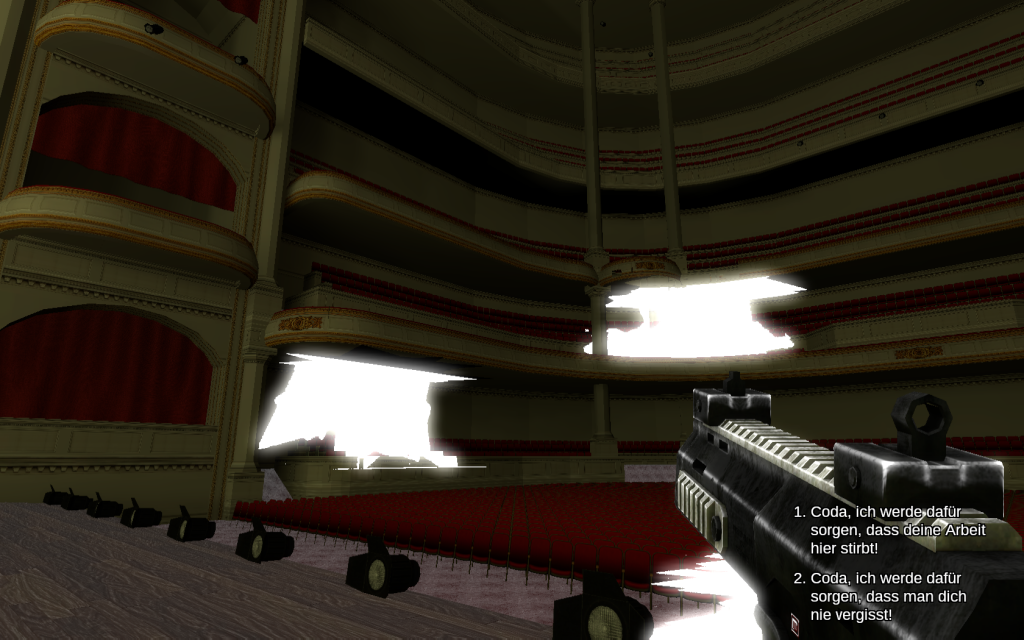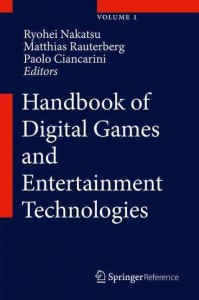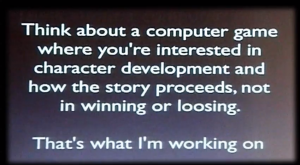The relationship between Artificial Intelligence and Narrative Theory is an important aspect of research into Interactive Narrative. In this book chapter, I consider its historical development and propose ways how to improve the relationship. Essentially, AI researchers also work on narrative theory and this contribution should be recognized by the humanities.
Author Archives: Hartmut
The Beginner’s Guide: Narrative as Game Rule
I just finished playing the new game by the creator of the Stanley Parable, The Beginner’s Guide. It was an interesting experience. I liked it, but I am not blown away. I would have preferred more interaction with the narrator. Yet, the Beginner’s Guide is significant in what it stands for. It is a high-profile narrative game that puts the emphasis on narrative, but is a game in its visuals and interaction.
So what actually happens in the game? The player experiences a first-person narrator who purports to be a game designer (the creator of the Stanley Parable, Davey Wreden, as himself) presenting the work of another game designer (Coda), whose works the player experiences. The narrator reflects on his relationship with coda and what a work can tell us about his/her creator. This narrative unfolds in voiceovers while the player traverses the virtual space of the different sections of the game, all of which supposedly represent different games made by Coda.

The Beginner’s Guide is not the first game to use location triggers to move the narrative forward. Dear Esther did just that and Gone Home continued in a somewhat similar fashion. And the omniscient narrator was already present in the Stanley Parable. However, the game makes use of narrative strategies, which, while they are well-known metanarrative devices in print-based literature, are rare in video games (however, Safe the Date is an interesting earlier case). Chiefly amongst them is the self-reflected unreliable narrator. It is also interesting how this narrative differs from the one in the Stanley Parable. In this game, the narrator had more of an overt function in the game play, as commentator, as guide, and as provocateur. In contrast, Beginner’s narrator is more of a self-obsessed ‘museum guide’ focused on his own narrative. And along with this shift, the player becomes more of an “active observer,” as the invisible narrator takes on the role of main character and his tale takes center stage.

So here we are. Beautiful game spaces to explore and a strong self-critical narrated narrative about relationships (between two game designers, but also between a work and its creator). And a player who is seemingly relegated to an observer role, while still allowed to roam freely. There are clear similarities with literary devices, but neither experience nor materiality are the same. And this is where the uncertainties end and the genre troubles start. Indeed, game designer and scholar Frank Lantz sees the game as a challenge for critics (and Molleindustria also has some thoughts). A simplistic perspective might therefore understand The Beginner’s Guide as the late revenge of narrative against its rejection in early game studies positions ca. 2001. Yes, games can be narrative, too and not only in an ornamental sense, but by unabashedly taking the limelight. Yet, maybe things are not so simple. Upon closer inspection, The Beginner’s Guide might not be a game at all, according to more narrow definitions of the term. What is the desired outcome, if we adopt Nick Montfort’s definition of game (“a structure of rules within which an outcome is sought”)(Montfort, 2003) There is no winning condition in Beginner’s Guide, nor can one actually loose. If anything can be “won” it is knowledge of the backstory that ties together the otherwise disjointed levels. And if one defines games as being about rules, what are the rules in a game where the player can only progress, but not level up, and where there are practically no challenges?

A way out of this predicament opens up once we consider progress as a rule. The way to break The Beginners Guide is to stop, to procrastinate, or even turn around, to go against its unidirectional progress. The existence of an opposite strategy confirms progress as a rule – if it can be broken, it must be a rule. So, we are dealing with a rule-based game after all. But what kind of rule is progress? Our existence is ruled by the progress of time, so progress by itself is unavoidable. Therefore we must be more specific about what kind of progress we have to consider here. Progress in The Beginner’s Guide is narrative progress. What does this mean? If progress is the rule of The Beginner’s Guide and progress is narrative progress, narrative is actually the rule of this game. The design of this significant work thus challenges the narrative/rule dichotomy that has been established in the early days of games studies. This is what makes this game significant. The Beginner’s Guide provides further evidence of the emancipation of narrative forms in interactive digital media from legacy models.
When literary-based narratology was rejected (and rightfully so) as an overall analytical framework for video games, the question of narrativity in games and other interactive experiences was left wide open. The narratology vs ludology debate avoided the discussion with practitioners and scholars interested in novel kinds of narrative that apply the specific affordances of digital media. Gonzala Frasca understood this already in 2003 when he lamented the fact that the “debate never took place.” (Frasca, 2003) Frasca here identifies a “narrativist” position between ludology and narratology. Further work on the narrativist position could have helped to identify specific conventions and structures of game narrative. Instead what has happened all too often is that literary narrative conceptions came back through the back door, no longer as a dominant structure but as a way to analyze the narrative elements of games. However, in order to identify literary devices, this practice effectively reduces game narrative to second order retellings and thereby turns them into altogether different phenomena – the game summary becomes the game narrative. If we agree that procedurality and participation are important in game narrative, that agency and transformation are important aspects, then we must reject the convenient, but reductionist views that accept “plot summaries” and even recorded walkthroughs as sufficient foundations for analysis. The difficulties in talking about the Beginner’s Guide expose these problems. It is high time to develop a video game narratology with specific methods and vocabulary.
Frasca, G. (2003). Ludologists love stories, too: notes from a debate that never took place. DIGRA Conf.
Montfort, N. (2003). Toward a Theory of Interactive Fiction. Retrieved February 11, 2016, from http://nickm.com/if/toward.html
Sim Civil War Meets Dinner Dash – Thoughts on “This War of Mine”
NB: This is the first installment of a developing post on This War of Mine. I will play it more and my opinion might change
As an expressive form, video games have long established themselves as a way to communicate serious topics, from HIV to oil sands exploitation. War is a new and important topic for games. No, not war as a soldier, as a party in the fighting – that certainly is old news. But war as experienced by non-combatants (in the day and age of asymmetrical opponents and civil wars, the word “civilian” does not seem to be a strong enough distinction anymore from those fighting) that try to survive alongside the hostilities, is a new topic.
I was excited when I heard about a game on non-combatants, as I envisioned a rich interactive narrative giving players a glimpse of the horrors of war, carrying an important message especially for those – like me – who have been so lucky to never have experienced it personally.

Central Issues in Interactive Narrative Part 4 – A discussion with Chris Crawford
In part 4 of the discussion, Chris talks about his latests project Siboot and identifies “five killer tasks in IDN,” while I bring up the question how the audience understands IDN.
Chris writes:
You’re right that the Holy Grail is beyond our reach; I have tacitly admitted as much with my Siboot project, which is half-game, half-storyworld. The interactive storytelling in Siboot uses only about three-quarters of the technology in SWAT; I have ripped out a lot of the more complex components. I dumped the ability to travel to stages; that’s all handled directly by the Engine. I limited Actor attributes to just three; I replaced the Tinkertoy Text system with an iconic system that is computationally simpler. Only two actors are allowed on a stage at once; no three-party interactions are allowed. There’s no hiding, no spying, and no automatic lie detection. I can’t recall some of the other simplifications I have made.
Central Issues in Interactive Narrative Part 3 – A discussion with Chris Crawford
In part 3 of the discussion, Chris expands on the disciplinary divide in the field, before discussing a communal approach versus the single genius. Finally, he lays out his approach and talks about his current project Siboot. In turn, I talk he audience and the difficulty to extend something as well known (by almost everybody) as narrative.
Chris:
Wow! That was a great piece. It’s sort of “A Quick Summary of the Field of IDN in 2500 Words or Less”. I don’t keep up with what others are doing, largely because I don’t have access to the printed academic literature and I can’t go to the academic conferences. On a deeper level, I’m a troglodytic lone wolf anyway. I *like* my cave!
I agree and disagree with everything you wrote — and that is my standard for perfection in writing. A good essay should include just enough agreeable content to command credence, and just enough disagreeable content to stimulate thought. I think you hit the perfect balance here.
Central Issues in Interactive Narrative Part 2 – A discussion with Chris Crawford
In part 1, the discussion started around the question of authorship in interactive narrative, this second part concentrates on the issue of computational story models and how different perspectives in this interdisciplinary field affect the discussion and research agenda. I also bring up the question of enabling collaboration through exchange standards.
Chris continues
I am pessimistic about the prospect of making interactive storytelling authorship available to Everyman. This was in fact the goal of the Erasmatron, and it was a spectacular failure — the system required was far to complicated. With Storytron I made some aspects of the technology more accessible, but the underlying model grew more complex.
The central problem, however, is the difficulty of creating a computable model for storytelling. Every effort I have seen relies on a different conception of the structure of a story and the process of storytelling. We cannot collaborate because we all see storytelling differently.
Central Issues in Interactive Narrative – A discussion with Chris Crawford
I wrote a paper summarizing central issues in interactive narrative, to be published in the Springer Lecture Series in Computer Science: Five Theses for Interactive Digital Narrative.
My intent was to start a discussion on the state of affairs in the field, on achievements, pertinent questions and areas for future research.
Chris Crawford reacted quickly and we entered in an ongoing discussion, which Chris and I decided to present here, inviting readers to comment and offer their views.
As it has grown long (and is still continuing at this point) I decided to present it in installments, although the complete discussion will be available, for those who want to read it in its entirety.
Why Interactive Narrative? Motivation and Opportunities
Save the Date – Cross-session Memory, Metanarrative and a Challenge to Endings
Save the Date is a real gem from the perspective of interactive digital narrative. This game puts the affordances of digital media to great use by demonstrating how procedurality and interactivity can extend narrative. At the same time, this work challenges long-standing conventions in both games and narrative.
So what does this game do? Save the Date reflects the player’s growing knowledge in consecutive replays though an evolving narrative. In addition, this work extends the notion of metanarrative in an important way and challenges the player to consider abandoning the game to reach a successful ending.
The Future of IDN: ICIDS 2014 Workshop
The Games & Narrativ group invites participants to a workshop on the future of Interactive Digital Narrative at ICIDS 2014 in Singapore.
After more than 25 years of fruitful research, starting with Brenda Laure’s 1986 PhD thesis, and productive practice in interactive digital narrative, it is a good time to consider future directions amid a maturing research field and a growing market for narrative-based interactive media. The Games & Narrative group invites participants to discuss ongoing issues as well successful methods and projects with us. On this foundation the workshop will enter into a phase of “futuring” – productive speculation – how will IDN look like in 5, 10, 25 or even 50 years? In addition to this, we will also take this opportunity to debate concrete initiatives, like joint research proposals, exploratory projects, forums for interdisciplinary dialogue, a central repository for projects or an academic/professional organization. The results of the workshop will be made available on the Games & Narrative website.


